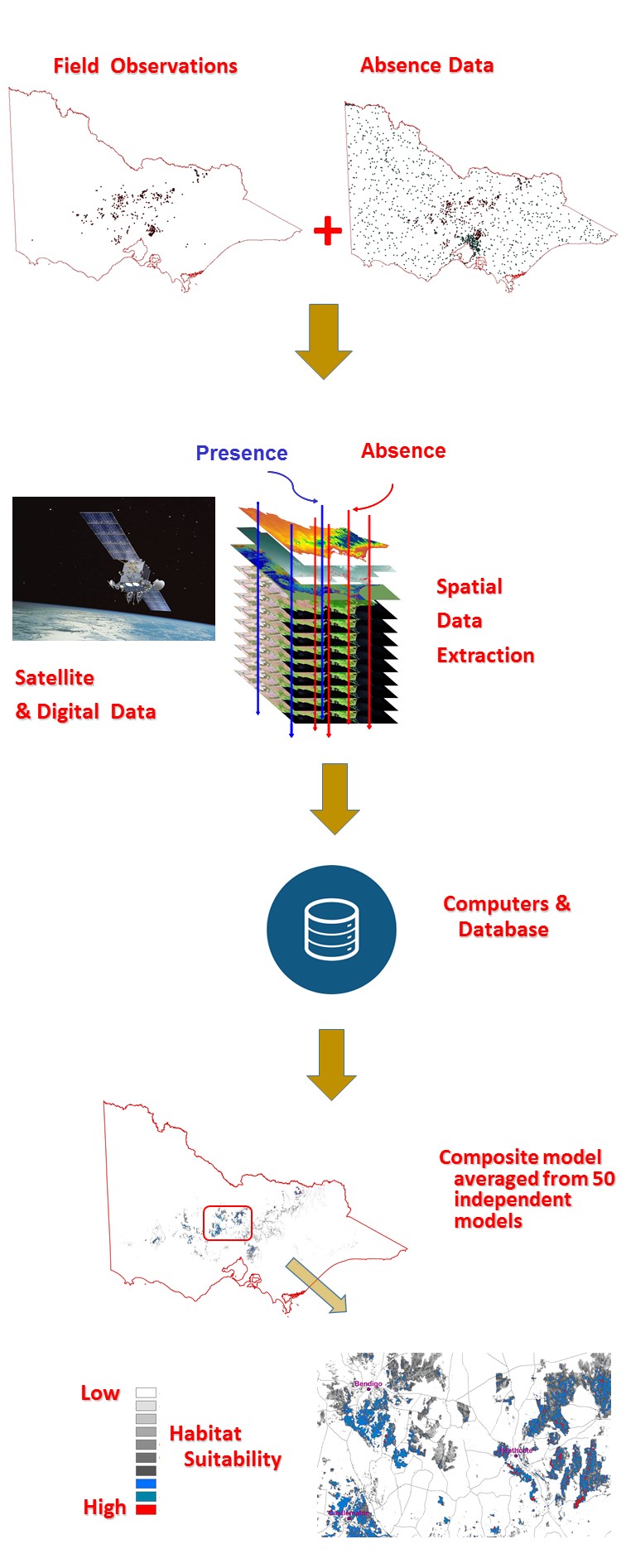Understanding the distribution of the habitat for our plant and animal species in Victoria is essential information for conservation management. This information becomes critical for rare or threatened taxa.
Habitat distribution models (HDMs) predict where suitable habitat may exist for a species, based in part on verified observations of the species in their natural environments. The models are mathematical relationships between confirmed species locations and sets of environmental predictors that provide detailed information on climate, terrain, local productivity, vegetation structure, etc. Once the model has been formed and evaluated, it can then be expressed as a mapped ‘habitat suitability’ index across Victoria, and beyond.
The data that are used to develop the models are the same observations that ecologists and land managers have been using for many years. In many ways, HDMs are the natural extension of what land managers were intuitively ‘calculating’ or ‘interpolating’ previously when planning the best management options. HDMs have now been developed for almost all of Victoria’s terrestrial flora and fauna species, with published versions currently available for all listed rare and threatened species.
HDMs developed by ARI are used by DELWP and other agencies for a wide variety of purposes including conservation planning processes, prioritising new survey areas, regulating permitted clearing of native vegetation, and assessing the value of landscapes at various spatial scales for single or multiple species (e.g. DELWP’s Strategic Biodiversity Values map). More recently these models have been incorporated into complex decision support tools, such DELWP’s Strategic Management Prospects (SMP), which helps land managers determine optimal investments and actions to support a broad suite of species.

Developing useful HDMs requires highly specialised technical expertise, including detailed consideration of data filtering techniques and selection of appropriate observations. New and relevant species observations along with continual improvements for information technology will provide opportunities to refine and maintain the usefulness of these products.
For more information contact: graeme.newell@delwp.vic.gov.au
See the DELWP NaturePrint page for information on the range of tools that use HDMs.
The journal articles listed below provide the technical details of what has been considered in the development of distribution models:
- Liu, C., White, M. and Newell, G. (2017) Detecting outliers in species distribution data. Journal of Biogeography (online early)
- Liu, C., White, M. and Newell, G. (2016) On the selection of thresholds for predicting species occurrence with presence-only data. Ecology and Evolution 6(1): 337-348
- Liu, C., White, M. and Newell, G. (2013) Selecting thresholds for the prediction of species occurrence with presence-only data. Journal of Biogeography 40(4): 778-789
- Liu, C., White, M., Newell, G. and Griffioen, P. (2013) Species distribution modelling for conservation planning in Victoria, Australia. Ecological Modelling 249: 68-74
- Liu, C., White, M. and Graeme, N. (2011) Measuring and comparing the accuracy of species distribution models with presence-absence data. Ecography 34(2): 232-243
- Sinclair S.J., White M.D. and Newell, G.R. (2010) How useful are species distribution models for managing biodiversity under future climates? Ecology and Society 15: 8
Page last updated: 23/06/20